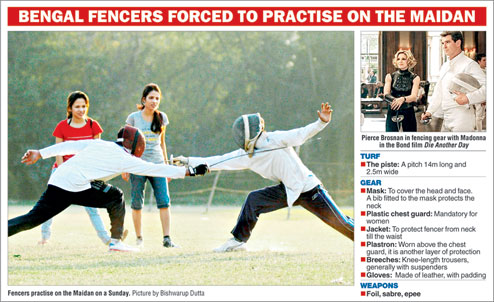 |
If you are walking by the Maidan and happen to spot a group of boys and girls charging at each other with swords, relax. They are not the hooligans Bengal needs to be wary of.
A state where sabre-rattling is an everyday political sport can’t provide a handful of real fencers representing it in national tournaments a proper place to practise.
So about 40 fencers, including newbies, assemble under the Gandhi statue at the Mayo Road-Dufferin Road crossing every Sunday to practise an Olympic sport that requires the silence of a church, an arena built to exact specifications and equipment three times more expensive than the average cricketer’s kit.
“I became interested in the sport after watching Olympic fencing on television. When a friend told me that he had taken up fencing, I went to see him practise and gradually got hooked,” Mohammad Shahid, a second-year student at South City College, told Metro.
Shahid and 23 other players are currently preparing for the annual inter-state championship, to be held in Rohtak from February 9 to 13. A top-eight finish will earn a ticket to the National Games in Kerala later in the year.
Fencer Nupur Khetan finds it amusing that anyone who stops to watch her and the rest of the group practise on the Maidan invariably has one question: “Don’t you get hurt?”
“Everyone is inquisitive about what we do. They ask us how dangerous it is to fight with a sword and how we fend off an attack,” said Nupur, a final-year college student.
Fencing apparently doesn’t expose a player to frequent injuries, as is the general impression. Those who play the sport say the chance of injury is much less than in cricket or football. “I have often had people asking me how many times I have been injured. We wear basic protective gear to avoid getting hurt. The maximum injury the players receive during training is a scratch,” said Santosh Pandey, the coach of the Bengal team.
But it does hurt that the people who matter care little for practitioners of a sport that already suffers from lack of popularity.
Fencing has featured in every Olympics since 1896 along with athletics, swimming, gymnastics and cycling. It has also been part of many movies, including the Bond film Die Another Day where Pierce Brosnan wields the sword for Her Majesty against an adversary trained by Madonna. Closer home, Uttam Kumar and Soumitra Chatterjee had engaged in a sword fight in the film Jhinder Bandi. Arya Stark from the cult TV series Game of Thrones learns fencing too.
In Calcutta, the few who have taken up fencing as a competitive sport got involved either through a family member or a friend. There are no stars to idolise or draw hundreds of others into the sport. There is no great reward waiting to be won either.
Within the circuit, those who have persisted with the sport command respect from their peers and juniors. But success in tournaments requires more than just perseverance, as coach Pandey points out.
The cost of the gear for one person is around Rs 40,000. None of those who practise on the Maidan owns any equipment except pieces of protective clothing. Whatever equipment is available belongs to the Bengal Fencing Association.
The fencers practise only on Sundays because traffic all around is lower than on a weekday, which helps them concentrate. There used to be a “piste” — the term for a fencing strip — at the SAI centre in Salt Lake stadium until the early part of the last decade. It was removed when the SAI facility underwent renovation.
Practising on the Maidan instead of an arena has already cost the Bengal team medals in various championships.
“Competitive fencing is conducted on wooden floors but we practise on a concrete surface (on the Maidan). In tournaments, we tend to slip while jousting,” said Nidhi Khetan, a Class XI student of Hariyana Vidya Mandir.
Fencers are judged manually at practice while points in tournaments are awarded on the basis of electronic surveillance. The difference in accuracy is telling.
“In tournaments, a wire attached to the swords is connected to an electronic board that determines the points. There are three types of swords —foil, sabre and epee. Only when a certain amount of pressure is applied at the tip of the sword does the electronic board award a point. So a fencer has to press the tip of the sword against his opponent with a certain amount of force to earn a point,” coach Pandey explained.
How much force to apply and when is something fencers in Bengal find difficult to learn without a proper practice facility equipped with an electronic scoreboard.
“We often misjudge how much pressure to be applied to win a point in a competition, as opposed to a practice session where we award points based on what the scorer sees,” fencer Dibakar Das said.
Das, who had once represented Jharkhand in a championship, said facilities were better in that state.
India too isn’t ranked anywhere near the top 100 countries in fencing. In fact, no fencer has yet qualified to represent the country in the Olympics.
Given the dismal administration of the sport, the few who take it up do so for the love of fencing. Not only do the fencers have little to play for, practising in a public place brings with it the danger of being mistaken for rowdies.
“I was once dragged to Fort William by an army man who thought that we were planning to attack someone. He was shocked to see me taking out swords from a bag and asked me several questions before asking me to accompany him to the army base,” coach Pandey recounted.
A senior officer at the Eastern Command headquarters was so impressed on learning that Pandey was a fencing coach that he offered him a job in an army school.
If only Bengal’s sports administrators were as impressed, Pandey and his wards wouldn’t be on the Maidan.
What message do you have for the fencers practising on the Maidan? Tell ttmetro@abpmail.com










